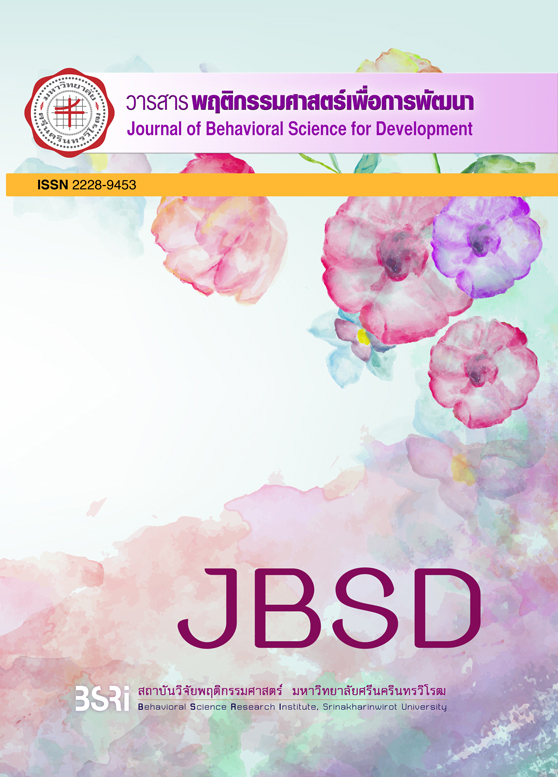The Study of Physical Activity in Daily Life for Health of Nursing Personnel and Staff in Nursing Department Siriraj Hospital and Faculty of Nursing Mahidol University การศึกษากิจกรรมในวิถีชีวิตประจำวันเพื่อการดำรงภาวะสุขภาพของบุคลากรฝ่ายการพยาบาล กิจกรรมในวิถีชีวิตประจำวัน
Keywords:
physical activity, daily life, nurses and staffAbstract
Now physical activity in Bangkok life style is less than minimal requirement for maintaining healthy status. This study aims to explore physical activity in daily life for health and related support and barrier factors of nurse personals in Nursing Department Siriraj Hospital and Faculty of Nursing Mahidol University and described facilitating factors of and barriers to healthy physical activity in daily life. Among 5,653 staffs, the 578 samples were recruited by simple random sampling and asked to participate after inform consent by answering the questionnaire modified from the physical activity in daily life appraisal of Ronda and et al and CDC. The data were analyzed by descriptive statistics. The findings revealed that most subjects were at the middle age female and (99%) reported that muscle pain after exercising was not the barrier to their physical activity. The subjects (43%) either decreased their physical activity or maintained their regular physical activity when they had anxiety, depression or stress. Most subjects performed walking in the same building as daily activities at work everyday or more than 3 times per week (91%). Most subjects (84%) took a glass of water by themselves as activities perform at home everyday. Regarding activities for leisure time, most subjects have activities with energy expenditure at a moderate level and take care of their health at a moderate level approximately 3 times a week. 86% of subjects reported that facilitating factors for exercise are exercise policy at work (86%). Most subjects reported that the most common aspects of barrier to exercise were stress and fatigue from work (65%), and lack of time due to busy work (50%). In sum, subjects in both settings reported that physical environments, exercise equipment, administration system, and personnel (coworkers) at work, family member at home, and friends at leisure time were significant facilitating factors. Recommendations: Both setting should promoting active physical activity into practice by integrating physical activities in daily life at work, home and leisure time. In addition, everyone should select to involve in active physical activity as much as possible. This strategy would encourage staff to modify their daily life behaviors perform active physical activities with high energy expenditure.
Key words: physical activity, daily life, nurses and staff
บทคัดย่อ
วิถีชีวิตประจำวันในปัจจุบันของคนกรุงเทพฯมีกิจกรรมที่เป็นการออกแรง และออกกำลังกายน้อยลงมากจนส่งผลกระทบต่อสุขภาพ การศึกษาครั้งนี้จึงมีวัตถุประสงค์เพื่อ 1) สำรวจการทำกิจกรรมในวิถีชีวิตประจำวันของบุคลากรฝ่ายการพยาบาลโรงพยาบาลศิริราชและคณะพยาบาลศาสตร์มหาวิทยาลัยมหิดล และ 2) สำรวจปัจจัยเอื้อ และอุปสรรคต่อการทำกิจกรรมในวิถีชีวิตประจำวันทั้งที่ทำงาน ที่บ้าน และยามพักผ่อนของประชากรทั้งหมด 5,653 คน จำนวนกลุ่มตัวอย่าง 578 คน โดยการสุ่มกลุ่มตัวอย่างแบบง่าย (Simple Random Sampling) เครื่องมือที่ใช้ในการวิจัยเป็นแบบสอบถามการทำกิจกรรมในวิถีชีวิตประจำวัน ซึ่งผู้วิจัยพัฒนาขึ้นจากแบบประเมินกิจกรรมในวิถีชีวิตประจำวันของรอนด้าและคณะ โดยนำกรอบการจัดประเภทกิจกรรมมาจากศูนย์ป้องกันโรคเรื้อรังและสร้างเสริมสุขภาพแห่งชาติ เก็บข้อมูลหลังจากผ่านการพิจารณารับรองจากคณะกรรมการจริยธรรมการวิจัยในคน ผลการศึกษาพบว่าบุคลากรส่วนใหญ่อยู่ในวัยผู้ใหญ่ตอนกลางและเป็นเพศหญิง ร้อยละ 99 ระบุว่าอาการปวดกล้ามเนื้อไม่ใช่อุปสรรคในการทำกิจกรรมที่ออกแรง กลุ่มตัวอย่างร้อยละ 43 ทำกิจกรรมออกแรงในชีวิตประจำวันลดลงหรือเท่าเดิมเมื่อมีความกังวล ซึมเศร้า หรือเครียด กลุ่มตัวอย่างส่วนใหญ่ทำกิจกรรมด้วยการเดินไปมาในอาคารที่ทำงานทุกวันหรือมากกว่า 3 ครั้งต่อสัปดาห์ (91%) กิจกรรมที่ทำที่บ้านมีการออกกำลังกายมากกว่าที่ทำงานเล็กน้อย เช่น การลุกรินน้ำเองแทนการสั่งคนอื่นทำ (84%) กิจกรรมที่กลุ่มตัวอย่างทำยามพักผ่อนมีการออกแรงในระดับปานกลางอย่างน้อย 3 ครั้งต่อสัปดาห์ โดยมี ปัจจัยเอื้อต่อการทำกิจกรรมออกแรง/ออกกำลังกายคือ ที่ทำงานมีนโยบายสนับสนุน (86%) ส่วนปัจจัยอุปสรรค คือ เหนื่อยล้าจากการทำงานจนไม่อยากออกกำลังกาย(65%) เครียดงานยุ่งมากจนไม่มีเวลาออกกำลังกาย (50%) ในภาพรวมกลุ่มตัวอย่างทั้งสองหน่วยงานระบุว่าบรรยากาศแวดล้อมด้านกายภาพ การมีอุปกรณ์ออกกำลังกาย ระบบการบริหารจัดการ และมีผู้ร่วมงานที่ทำงาน สมาชิกในครอบครัว และเพื่อนในยามพักผ่อนร่วมออกกำลังกายเป็นปัจจัยเอื้อที่สำคัญต่อการทำกิจกรรมออกกำลังกาย
คำสำคัญ: กิจกรรมทางกาย นวิถีชีวิตประจำวัน พยาบาลและบุคลากร




